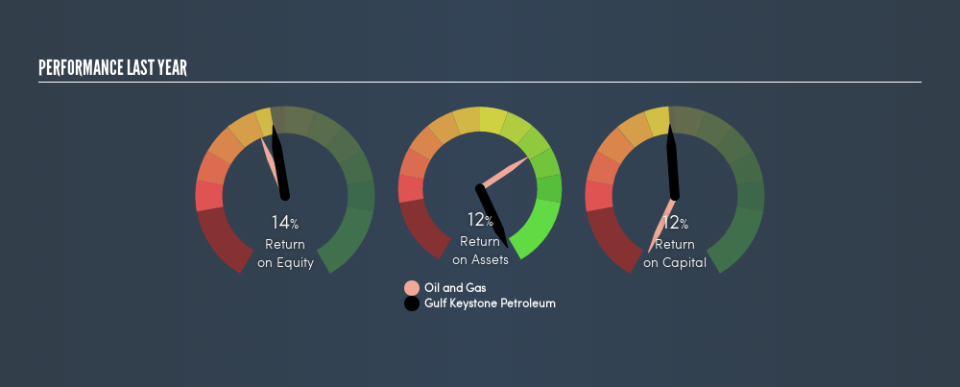Should You Like Gulf Keystone Petroleum Limited’s (LON:GKP) High Return On Capital Employed?

Today we'll evaluate Gulf Keystone Petroleum Limited (LON:GKP) to determine whether it could have potential as an investment idea. In particular, we'll consider its Return On Capital Employed (ROCE), as that can give us insight into how profitably the company is able to employ capital in its business.
First of all, we'll work out how to calculate ROCE. Then we'll compare its ROCE to similar companies. Last but not least, we'll look at what impact its current liabilities have on its ROCE.
Understanding Return On Capital Employed (ROCE)
ROCE is a metric for evaluating how much pre-tax income (in percentage terms) a company earns on the capital invested in its business. Generally speaking a higher ROCE is better. Overall, it is a valuable metric that has its flaws. Renowned investment researcher Michael Mauboussin has suggested that a high ROCE can indicate that 'one dollar invested in the company generates value of more than one dollar'.
So, How Do We Calculate ROCE?
Analysts use this formula to calculate return on capital employed:
Return on Capital Employed = Earnings Before Interest and Tax (EBIT) ÷ (Total Assets - Current Liabilities)
Or for Gulf Keystone Petroleum:
0.12 = US$77m ÷ (US$759m - US$86m) (Based on the trailing twelve months to December 2018.)
Therefore, Gulf Keystone Petroleum has an ROCE of 12%.
See our latest analysis for Gulf Keystone Petroleum
Does Gulf Keystone Petroleum Have A Good ROCE?
One way to assess ROCE is to compare similar companies. Gulf Keystone Petroleum's ROCE appears to be substantially greater than the 7.6% average in the Oil and Gas industry. We consider this a positive sign, because it suggests it uses capital more efficiently than similar companies. Separate from Gulf Keystone Petroleum's performance relative to its industry, its ROCE in absolute terms looks satisfactory, and it may be worth researching in more depth.
Gulf Keystone Petroleum delivered an ROCE of 12%, which is better than 3 years ago, as was making losses back then. That suggests the business has returned to profitability. The image below shows how Gulf Keystone Petroleum's ROCE compares to its industry, and you can click it to see more detail on its past growth.
When considering ROCE, bear in mind that it reflects the past and does not necessarily predict the future. ROCE can be misleading for companies in cyclical industries, with returns looking impressive during the boom times, but very weak during the busts. ROCE is, after all, simply a snap shot of a single year. We note Gulf Keystone Petroleum could be considered a cyclical business. Future performance is what matters, and you can see analyst predictions in our free report on analyst forecasts for the company.
Do Gulf Keystone Petroleum's Current Liabilities Skew Its ROCE?
Short term (or current) liabilities, are things like supplier invoices, overdrafts, or tax bills that need to be paid within 12 months. The ROCE equation subtracts current liabilities from capital employed, so a company with a lot of current liabilities appears to have less capital employed, and a higher ROCE than otherwise. To check the impact of this, we calculate if a company has high current liabilities relative to its total assets.
Gulf Keystone Petroleum has total assets of US$759m and current liabilities of US$86m. As a result, its current liabilities are equal to approximately 11% of its total assets. Current liabilities are minimal, limiting the impact on ROCE.
What We Can Learn From Gulf Keystone Petroleum's ROCE
Overall, Gulf Keystone Petroleum has a decent ROCE and could be worthy of further research. Gulf Keystone Petroleum shapes up well under this analysis, but it is far from the only business delivering excellent numbers . You might also want to check this free collection of companies delivering excellent earnings growth.
For those who like to find winning investments this free list of growing companies with recent insider purchasing, could be just the ticket.
We aim to bring you long-term focused research analysis driven by fundamental data. Note that our analysis may not factor in the latest price-sensitive company announcements or qualitative material.
If you spot an error that warrants correction, please contact the editor at editorial-team@simplywallst.com. This article by Simply Wall St is general in nature. It does not constitute a recommendation to buy or sell any stock, and does not take account of your objectives, or your financial situation. Simply Wall St has no position in the stocks mentioned. Thank you for reading.

 Yahoo Finance
Yahoo Finance 
